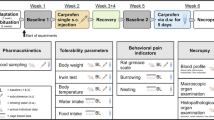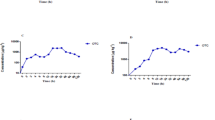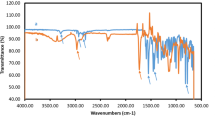Abstract
Aim:
Tolsultazolamide, a novel carbonic anhydrase inhibitor, is designed for the prophylaxis and treatment of acute mountain sickness. The aim of this study was to investigate the pharmacokinetics, tissue distribution, and excretion characteristics of tolsultazolamide and the sex difference in pharmacokinetics in rats.
Methods:
For pharmacokinetic study, rats were intravenously injected tolsultazolamide at 1 and 2 mg/kg or orally administered tolsultazolamide at 20, 40, or 80 mg/kg) in a pharmacokinetic study. The concentrations of tolsultazolamide in plasma were determined with high-performance liquid chromatography, with a liquid–liquid extraction. For tissue distribution study, tolsultazolamide (80 mg/kg) was orally administered to overnight fasted rats (six per group and three per sex). Samples were collected from the brain, heart, lung, liver, spleen, muscle, kidney, stomach, fat, intestines, pancreas and sexual gland. For excretion study, tolsultazolamide (40 mg/kg) was orally administered to 6 rats (three per sex). The urine, feces, and bile samples were collected at 24, 48, and 72 h.
Results:
After its intravenous administration, tolsultazolamide was rapidly eliminated from the plasma, with T1/2 of about 60–90 min. The AUC0–t and the initial concentration (C0) values were proportional to the intravenous doses. After its oral administration, tolsultazolamide showed dose-independent pharmacokinetic characteristics, with Tmax and T1/2 of approximately 2 h and 5–7 h, respectively, and good oral absolute bioavailability of about 60%. Tolsultazolamide was distributed widely in various tissues. The highest tolsultazolamide levels were detected in the stomach, intestine, spleen, lung, and kidney. Total excretion of unchanged tolsultazolamide in the urine, feces, and bile was less than 2%. The Cmax and AUC of tolsultazolamide were significantly higher in female rats than those in male rats. Clearance and volume of distribution were greater in male rats than those in female rats. The oral absolute bioavailability was also significantly different between female rats (about 83%) and male rats (about 37%).
Conclusion:
Tolsultazolamide was well absorbed and widely distributed in the rat, and very little of the unchanged form was excreted. Sex had a significant effect on the pharmacokinetics of tolsultazolamide.
Similar content being viewed by others
Log in or create a free account to read this content
Gain free access to this article, as well as selected content from this journal and more on nature.com
or
References
Roach RC, Hackett PH . Frontiers of hypoxia research: acute mountain sickness. J Exp Biol 2001; 204: 3161–70.
Clarke C . Acute mountain sickness: medical problems associated with acute and subacute exposure to hypobaric hypoxia. Postgrad Med J 2006; 82: 748–53.
Imray C, Wright A, Subudhi A, Roach R . Acute mountain sickness: pathophysiology, prevention, and treatment. Prog Cardiovasc Dis 2010; 52: 467–84.
Murdoch D . Altitude sickness. Clin Evid 2010; 3: 1209–19.
Kayser B, Dumont L, Lysakowski C, Combescure C, Haller G, Tramèr MR . Reappraisal of acetazolamide for the prevention of acute mountain sickness: a systematic review and meta-analysis. High Alt Med Biol 2012; 13: 82–92.
Low EV, Avery AJ, Gupta V . Identifying the lowest effective dose of acetazolamide for the prophylaxis of acute mountain sickness: systematic review and meta-analysis. BMJ 2012; 345: e6779.
Ritchie ND, Baggott AV, Andrew Todd WT . Acetazolamide for the prevention of acute mountain sickness — A systematic review and meta-analysis. J Travel Med 2012; 19: 298–307.
Seupaul RA, Welch JL, Malka ST, Emmett TW . Pharmacologic prophylaxis for acute mountain sickness: a systematic shortcut review. Ann Emerg Med 2012; 59: 307–17.
Shu YG, Zhang DX, Xiao ZH, Cui WY, Nie HJ, Zhang YK, et al. Effect of neotype carbonic anhydrase target-based inhibitors (P-8) on the hypoxic tolerance in mice. Chin J Appl Physiol 2011; 27: 276–9.
Xiao ZH, Duan RF, Cui WY, Zhang YF, Zhang SG, Chen FJ, et al. Synthesis and evaluation of new carbonic anhydrase inhibitors. Bioorg Med Chem 2011; 19: 3221–8.
He CY, Wang S, Feng Y, Liang S, Lin X, Xu DS, et al. Pharmacokinetic, tissue distribution and metabolism of senkyunolide I, a major bioactive component in Ligusticum chuanxiong Hort (Umbelliferae). J Ethnopharmacol 2012; 142: 706–13.
Zhang Z, Liu YY, Su MQ, Liang XF, Wang WF, Zhu X . Pharmacokinetics, tissue distribution and excretion study of dl-praeruptorin A of Peucedanum praeruptorum in rats by liquid chromatography tandem mass spectrometry. Phytomedicine 2011; 18: 527–32.
Lee SH, Gu N, Kim BH, Lim KS, Shin SG, Jang IJ, et al. Pharmacokinetic and pharmacodynamics properties of the calcimimetic agent cinacalcet (KRN1493) in healthy male Korean subjects: a randomized, open-label, single ascending-dose, parallel-group study. Clin Ther 2012; 34: 1160–9.
Geng T, Sun Y, Yao WF, Ding AW, Zhang L, Guo JM, et al. Pharmacokinetics and tissue distribution of schizonepetin in rats. Fitoterapia 2011; 82: 1110–7.
LV GY, Lou ZH, Chen SH, Gu H, Shan LT . Pharmacokinetics and tissue distribution of 2,3,5,4′-tetrahydroxystilbene-2-O-β-D-glucoside from traditional Chinese medicine Polygonum multiflorum following oral administration to rats. J Ethnopharmacol 2011; 137: 449–56.
Yin QW, Sun H, Zhang AH, Wang XJ . Pharmacokinetics and tissue distribution study of scoparone in rats by ultraperformance liquid-chromatography with tandem high-definition mass spectrometry. Fitoterapia 2012; 83: 795–800.
Leaf DE, Goldfarb DS . Mechanisms of action of acetazolamide in the prophylaxis and treatment of acute mountain sickness. J Appl Physiol 2007; 102: 1313–22.
Swenson ER . Prevention of acute mountain sickness by acetazolamide: as yet an unfinished story. J Appl Physiol 2007; 102: 1305–7.
Franconi F, Brunelleschi S, Steardo L, Cuomo V . Gender differences in drug responses. Pharmacol Res 2007; 55: 81–95.
Schwartz JB . The influence of sex on pharmacokinetics. Clin Pharmacokinet 2003; 42: 107–21.
Soldin OP, Mattison DR . Sex differences in pharmacokinetics and pharmacodynamics. Clin Pharmacokinet 2009; 48: 143–57.
Rankin GO . Acetazolamide. In: Enna SJ, Bylund DB, Editors-in-Chief. Xpharm: the comprehensive pharmacology reference. Elsevier Inc. 2007. p 1–5.
Li XY, Gao F, Li ZQ, Guan W, Feng WL, Ge RL . Comparison of the pharmacokinetics of sulfamethoxazole in male Chinese volunteers at low altitude and acute exposure to high altitude versus subjects living chronically at high altitude: an open-label, controlled, prospective study. Clin Ther 2009; 31: 2744–54.
Acknowledgements
This work was supported by grant from the State Key Project of Drug Research and Development of China (Grant No 2012ZX09J12109–01B).
Author information
Authors and Affiliations
Corresponding author
Additional information
Supplementary information was available on the APS's website.
Rights and permissions
About this article
Cite this article
Wang, Jd., Shi, Yp., Yin, J. et al. Bioavailability, tissue distribution, and excretion characteristics of the novel carbonic anhydrase inhibitor tolsultazolamide in rats. Acta Pharmacol Sin 35, 275–282 (2014). https://doi.org/10.1038/aps.2013.146
Received:
Accepted:
Published:
Issue date:
DOI: https://doi.org/10.1038/aps.2013.146



